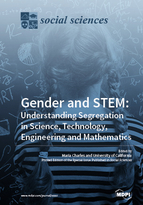Gender and STEM: Understanding Segregation in Science, Technology, Engineering and Mathematics
A special issue of Social Sciences (ISSN 2076-0760). This special issue belongs to the section "Gender Studies".
Deadline for manuscript submissions: closed (31 August 2016) | Viewed by 159712
Special Issue Editors
Interests: gender; educational and occupational inequalities; global and transnational sociology; cultural ideologies and stereotypes
Special Issue Information
Dear Colleagues,
This Special Issue will feature empirical studies on the causes and consequences of women’s underrepresentation in scientific, technical, engineering, and mathematics (“STEM”) occupations and fields of study. Although women have made great strides in gaining access to labor markets and systems of higher education around the world, many STEM fields—particularly in the physical sciences and engineering—remain strongly male dominated in reputably gender-progressive societies. The goal of this volume is to apply diverse theoretical lenses and methodological approaches to understand the individual, interactional, organizational, structural, and cultural dynamics underlying gender segregation of STEM fields, including how gender interacts with racial, ethnic, class, and/or sexual identities, and how these dynamics vary across time, across societies, and across organizational contexts. Submissions should engage with the existing literature on this topic and be written in a nontechnical style accessible to a broad interdisciplinary audience.
Prof. Maria Charles
Prof. Sarah Thébaud
Guest Editors
Manuscript Submission Information
Manuscripts should be submitted online at www.mdpi.com by registering and logging in to this website. Once you are registered, click here to go to the submission form. Manuscripts can be submitted until the deadline. All papers will be peer-reviewed. Accepted papers will be published continuously in the journal (as soon as accepted) and will be listed together on the special issue website. Research articles, review articles as well as short communications are invited. For planned papers, a title and short abstract (about 100 words) can be sent to the Editorial Office for announcement on this website.
Submitted manuscripts should not have been published previously, nor be under consideration for publication elsewhere (except conference proceedings papers). All manuscripts are thoroughly refereed through a double-blind peer-review process. A guide for authors and other relevant information for submission of manuscripts is available on the Instructions for Authors page. Social Sciences is an international peer-reviewed open access monthly journal published by MDPI.
Please visit the Instructions for Authors page before submitting a manuscript. Submitted papers should be well formatted and use good English. Authors may use MDPI's English editing service prior to publication or during author revisions.
Keywords
- Gender
- STEM
- Race/ethnicity
- Sexuality
- Science
- Engineering
- Mathematics
- Segregation
- Inequality
- Women
- Men







